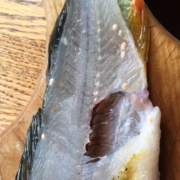Yellow Grub
Taking a three-year-old fishing is chock full of lessons. There are predictable ones: ichthyology, self-sufficiency, cause and effect. (“If you throw all the worms in the water, honey, we won’t have worms to fish with.”)
And then there are the random lessons you don’t expect to learn, let alone teach, like the ones involving the parasitic yellow grubs that you might find in perch meat. These animals have life cycles that, coolly enough, involve the blue herons that were flying over us while we fished, and the snails we were noticing on the bottom of the lake floor under the bridge we were fishing on.
So in the picture above you’ll see the cysts that were in the perch fillets. The grubs (Clinostomum marginatum) are inside. Humans aren’t part of the parasite’s lifecycle, and they die when you cook them, so the meat is still edible, if not exactly appetizing.
The parasite starts its life in an egg in a heron or a bittern’s throat. The egg is either regurgitated into the water as the bird feeds or shat out – reputable sources vary on that detail, which could be an indication that both things are possible. Once free of the bird, the egg hatches and the miracidia, as the little organism is called, finds a snail to infect. The parasite goes through several larval stages in the snail, then leaves the snail to find a fish. It infects a fish, then gets passed to a fish-eating bird when the fish is eaten. Once in the bird’s throat, the adult lays eggs and the lifecycle starts anew.

